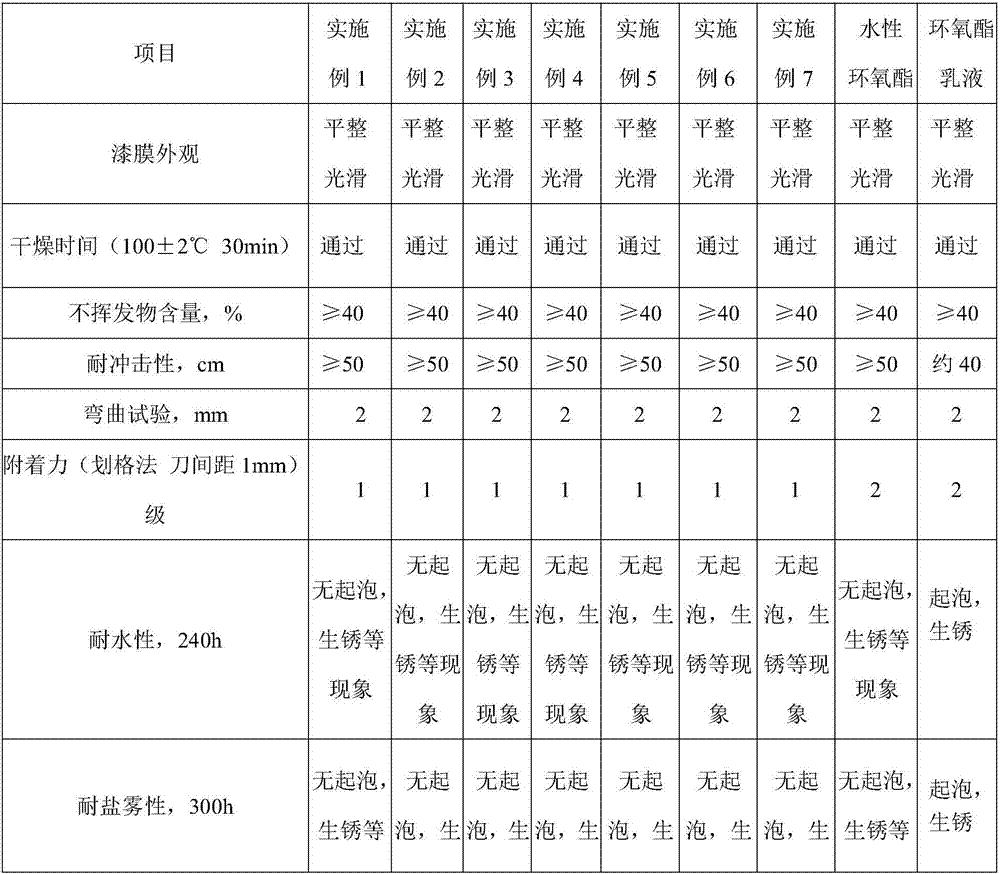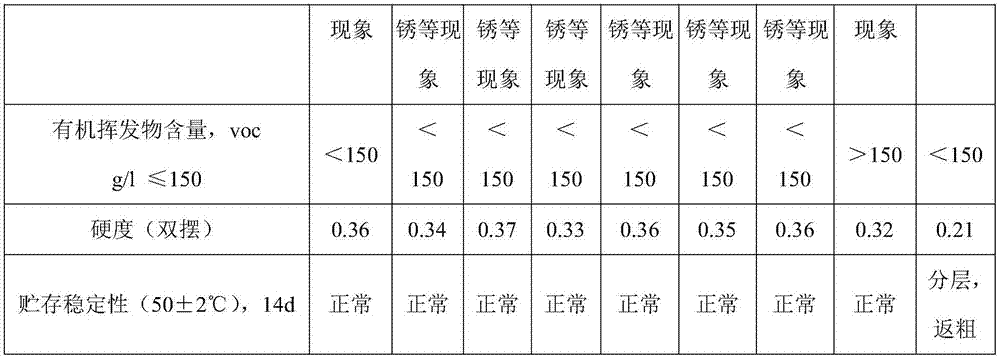Epoxy ester resin capable of being dispersed in water and preparing method thereof
A technology of epoxy ester resin and epoxy resin, which is applied in the field of coatings, can solve the problems of reducing anti-corrosion performance, affecting storage stability, and affecting drying time, and achieves the effects of good hydrolysis resistance stability, low cost, and fast drying
- Summary
- Abstract
- Description
- Claims
- Application Information
AI Technical Summary
Problems solved by technology
Method used
Image
Examples
Embodiment 1
[0019] Epoxy ester resin, comprises the component of following parts by weight: 20 parts of cardanol, 21.5 parts of 601 epoxy resins, 1.2 parts of soybean oil, 0.5 parts of phthalic anhydride, 3.3 parts of PEG600, 5.5 parts of Xylene, 48 parts of deionized water.
[0020] Put 20 parts of cardanol and 21.5 parts of 601 epoxy resin into a stainless steel reaction kettle, seal the feeding port, open the vent valve, pass nitrogen, and raise the temperature. When the temperature reaches 120°C, start stirring, and heat up to 210°C for 2.5 h, until the acid value is below 0.5mgKOH / g; add 1.2 parts of soy oil, 3.3 parts of PEG 600, and 0.5 parts of phthalic anhydride, raise the temperature to 220 ° C, keep it for 2.5 hours, until the acid value is below 0.7 mgKOH / g ; Cool down to 160°C and add 5.5 parts of xylene, continue to cool down to 60°C; maintain a constant temperature at this temperature, under stirring, gradually add 48 parts of deionized water and stir evenly, the process of...
Embodiment 2
[0022] Epoxy ester resin comprises the following components by weight: 22 parts of cardanol, 13 parts of 601 epoxy resin, 4 parts of 6101 epoxy resin, 1.4 parts of linoleic acid, 0.3 part of phthalic anhydride , 4 parts of PEG 800, 4.3 parts of mesitylene, 51 parts of deionized water.
[0023] Put 22 parts of cardanol, 13 parts of 601 epoxy resin, and 4 parts of 6101 epoxy resin into a stainless steel reaction kettle, seal the feeding port, open the vent valve, pass nitrogen, and raise the temperature. When the temperature reaches 120°C, start stirring , raise the temperature to 205°C and keep it warm for 3 hours until the acid value reaches below 0.5mgKOH / g; add 1.4 parts of linolenic acid, 4 parts of PEG 800, and 0.3 parts of phthalic anhydride, raise the temperature to 225°C, and keep it warm for 2 hours. The acid value is below 0.7mgKOH / g; cool down to 160°C, add 4.3 parts of trimethylbenzene, and continue to cool down to 50°C; keep a constant temperature at this temperatu...
Embodiment 3
[0025] Epoxy ester resin comprises the following components by weight: 18 parts of cardanol, 23 parts of 6101 epoxy resin, 1.2 parts of linoleic acid, 0.4 parts of phthalic anhydride, 3.2 parts of PEG600, 3 parts Xylene, 2.2 parts of trimethylbenzene, 49 parts of deionized water.
[0026] Put 18 parts of cardanol and 23 parts of 6101 epoxy resin into a stainless steel reaction kettle, seal the feeding port, open the vent valve, pass nitrogen, and raise the temperature. When the temperature reaches 120°C, start stirring, and heat up to 215°C for 2 hours. , until the acid value reaches below 0.5mgKOH / g; add 1.2 parts of linolenic acid, 3.2 parts of PEG 600, 0.4 parts of phthalic anhydride, raise the temperature to 215 ° C, keep warm for 3 hours, until the acid value is below 0.7mgKOH / g ; Cool down to 160°C, add 3 parts of xylene and 2.2 parts of trimethylbenzene, and continue to cool down to 70°C; maintain a constant temperature at this temperature, add 49 parts of deionized wat...
PUM
 Login to View More
Login to View More Abstract
Description
Claims
Application Information
 Login to View More
Login to View More - R&D
- Intellectual Property
- Life Sciences
- Materials
- Tech Scout
- Unparalleled Data Quality
- Higher Quality Content
- 60% Fewer Hallucinations
Browse by: Latest US Patents, China's latest patents, Technical Efficacy Thesaurus, Application Domain, Technology Topic, Popular Technical Reports.
© 2025 PatSnap. All rights reserved.Legal|Privacy policy|Modern Slavery Act Transparency Statement|Sitemap|About US| Contact US: help@patsnap.com



